-
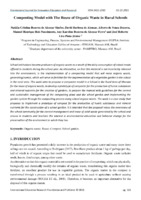 COMPOSTING MODEL WITH THE REUSE OF ORGANIC WASTE IN RURAL SCHOOLS
COMPOSTING MODEL WITH THE REUSE OF ORGANIC WASTE IN RURAL SCHOOLS School institutions become producers of organic waste as a result of the daily consumption of school meals offered to students during the school year. An alternative, so that this material is not incorrectly released into the environment, is the implementation of a composting model that will reuse organic waste, generating humus, which will serve as fertilizer for the implementation of a vegetable garden in the school in the rural area. This work aims to propose a composter model in a School in the Rural Area of Manaus for the reuse of organic waste, to develop a prototype of composter for the production of humic substances and mineral nutrients for the creation of gardens, to prepare the manual with guidelines for the correct and sustainable management of the composting plant and the school garden and implementing the garden system through the composting process using school organic waste. The work is a case study that proposes to implement a prototype of compost for the production of humic substances and mineral nutrients for the construction of a school garden. It is intended that the proposal raises the awareness of the school community for the correct management and reuse of solid waste generated by the school and arouse in students and teachers the interest in environmental education and behavior change for the preservation of the environment in which they live
-
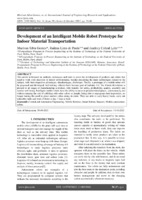 Development of an Intelligent Mobile Robot Prototype for Indoor Material Transportation
Development of an Intelligent Mobile Robot Prototype for Indoor Material Transportation This article is focused on methods, techniques and tools to assist the development of products and robots that
need to work with precision in indoor environments, besides presenting the main technologies related to the
subject, with their respective advantages, disadvantages, challenges. Finally, a prototype of a mobile robot will
be proposed and developed. Self-driving vehicles have become part of Industry 4.0. The Fourth Revolution is
present in all stages of manufacturing a product, with benefits for safety, profitability, quality, assembly and
worker well-being. Intelligent mobile robots have the ability to move in predetermined places, autonomously and
without running the risk of colliding with other robots or people, being able to reprogram their trajectories, no
longer having the need to place markers when along its route. They are able to carry heavy loads, carry out
unhealthy tasks and work 24 hours a day, 7 days a week.
-
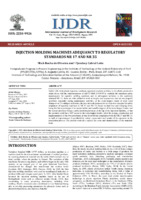 INJECTION MOLDING MACHINES ADEQUANCY TO REGULATORY STANDARDS NR 17 AND NR 35
INJECTION MOLDING MACHINES ADEQUANCY TO REGULATORY STANDARDS NR 17 AND NR 35 Safety risks with plastic injection machines represent a serious problem in the plastic production
chain. Even with the implementation of ABNT NBR 13536/95 to establish the minimum safety
requirements for injection molding machines and its subsequent inclusion in the regulatory
standard NR 12, there are risks related to work at heights and ergonomics that are not properly
specified, especially during maintenance activities of the resin hopper loader or resin color
change-over. To mitigate such risks, the present work proposes to develop two concepts for safety
adaptation of injection machines to NR 17 and NR 35, based on their size and clamping force,
being the first a prototype of an access ladder and metallic support of the resin hopper loader, and
the second prototype being a safety platform prototype at the top of the injection machine, so that
the operator could have 360º access to the resin hopper loader. After the design, construction and
implementation of the two prototypes, it was observed the compliance with the NR 17 and NR 35,
as well as improvements in productivity, safety, ergonomics and morale of the operators in the
production process. The present work also exposes the costs and characteristics of the materials
used.
-
 Implementation of a Supervisory System in Electric Power Generating Units of Isolated Systems Installed In Municipalities of the Amazonas State
Implementation of a Supervisory System in Electric Power Generating Units of Isolated Systems Installed In Municipalities of the Amazonas State This research consists of an exploratory research carried out by monitoring the maintenance activities carried out
in the Thermoelectric Power Plants installed in the cities of the State of Amazonas, with the objective of
implementing a monitoring system for electrical quantities coming from engines, also called Engenies Electric
Power. This is a field research with qualitative approaches, taking into account the implementation of an
automated system to capture the variations in electrical quantities (Voltage, Current, Power and Power Factor) of
these energy generating units. The capture of these data, which are the variations of electrical quantities, occurs
with the use of PLC, transducers, Modem, among other equipment, which are stored in a database (computer)
that using a Supervisory System modeled for this purpose, providing the visualization of these data, in real time,
in a friendly and interactive interface. From the monitoring of these data, via a Supervisory System, and with the
use of data manipulation tools from the SCADA system, an interface for the generation of graphics was
modeled, which significantly contributed to the interpretation of these data. And in addition, make it available
remotely, to everyone involved in the activities of the plants, thus being able to access the Supervisory System
from anywhere in the world, through the internet.
-
 Swot Analysis Implemented with Fuzzy Inference to Support Decision Making
Swot Analysis Implemented with Fuzzy Inference to Support Decision Making Current market conditions require organizations to understand the business environment in order to
achieve strategic planning and decision-making processes. An organization's competitive advantage is
associated with an understanding of how to determine the potential of these companies when examining
internal and external conditions (insertions) and the effort to meet customer needs. Among the many tools
that contribute to this understanding, the SWOT analysis stands out, which can assist organizations to
better understand the internal and external environment and formulate strategic plans in a collaborative
way. This work aimed to implement an evaluation model for SWOT analysis using fuzzy inference methods.
The adopted methodology started from a survey on the internal and external characteristics of the
organization, definition of the linguistic criteria of the SWOT matrix, correlation between the variables
found and elaboration of the fuzzy inference system for crossing the inputs. The approach proposed by the
Fuzzy Inference model for the SWOT matrix proved to be simplified and efficient for a better collection of
information that allows the prediction of the future environment, enabling reasoned strategies resulting
from the model presented
-
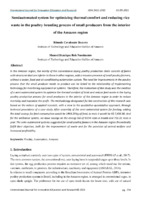 Semiautomatedsystem for optimizing thermal comfort and reducing rice waste in the poultry breeding process of small producers from the interior of the Amazon region
Semiautomatedsystem for optimizing thermal comfort and reducing rice waste in the poultry breeding process of small producers from the interior of the Amazon region In the Amazon region, the reality of the conventional laying poultry production chain consists of farms with structures that are inferior to those in other regions, with a massive presence of small poultry farmers, without a water, food and air conditioning automation system. The need for improvements in the poultry process that the small producer needs to produce can be linked to the relationship of implementing technology for monitoring equipment or systems. Therefore, the motivation of this study was the creation of a semi-automated system to optimize the thermal comfort of birds and reduce feed waste in the laying poultry production process for small producers in the interior of the Amazon region in order to reduce mortality and maximize the profit. The methodology designated for the construction of this research was based on the nature of applied research, with a view to the qualitative-quantitative approach, through technical procedures of a case study. After assembly of the semi-automated system for feeding, adding the total savings for feed consumption would be 1964.20 kg of feed, in reais it would be R$ 7,856.80. And for the ambiance system, we have savings on the energy bill of 60.94 reais a month and 731.31 reais a year. The semi-automated systems suggested for small poultry farmers in the Amazon region theoretically fulfill their objective, both for the improvement of waste and for the provision of animal welfare and increased profitability
-
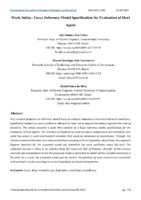 Work Safety: Fuzzy Inference Model Specification for Evaluation of Heat Agent
Work Safety: Fuzzy Inference Model Specification for Evaluation of Heat Agent This research proposes an inference model fuzzy to analyses hazardous environmental work conditions,
specifically insalubrious work conditions relevant for heat risk to support the safety engineers for making
decisions. The article presents a study that consists of a fuzzy inference model specification for the
evaluation of heat agents. The structure of model fuzzy used are inputs temperature and metabolic rate,
while the output is work environment condition that could be salubrious or insalubrious. Through, the
inference method Mamdani and rules established according to Brazil legislation about heat, Occupational
Hygiene Standard 06, the proposed model can determine the work conditions about the heat. The
validation process is done in an industry from the Industrial Pole of Manaus, therefor all the process
necessary for preparations to use the proposed model is described to obtain all the variables necessary in
the field. As a result, the proposed model got the correct classification of work environment conditions
with pertinent results according to current legislation and technical expertise
-
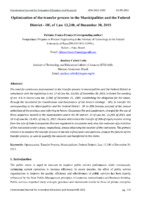 Optimization of the transfer process to the Municipalities and the Federal District - DF, of Law 13,240, of December 30, 2015
Optimization of the transfer process to the Municipalities and the Federal District - DF, of Law 13,240, of December 30, 2015 The need for continuous improvement in the transfer process to municipalities and the Federal District in
compliance with the legislation in art. 27 of Law No. 13,240, of December 30, 2015, included the wording
of art. 6-B in Decree-Law No. 2,398, of December 21, 1987, establishing the obligation for the Union,
through the Secretariat for Coordination and Governance of the Union's Heritage - SPU, to transfer the
corresponding to the Municipalities and the Federal District - DF to 20% (twenty percent) of the annual
collections of the previous year referring to Forum, Occupancy Fee and Laudemium, charged for the use of
those properties located in the municipalities and in the DF and art. 17 of Law No. 13,240, of 2015, and
16-G of Law No. 13,465, of July 11, 2017, likewise determined the transfer of 20% of equity income arising
from the sale of Federal properties that are registered in occupation and, also, the remission of jurisdiction
of the real estate under a lease, respectively, always observing the location of the real estate. The primary
interest is to examine the transfer process in the last 5 (five) years and optimize, analyze the failures of the
transfer process, as well as quantify the amounts not transferred to the states.
-
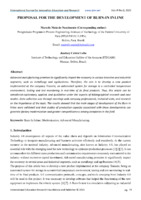 PROPOSAL FOR THE DEVELOPMENT OF BURN-IN INLINE
PROPOSAL FOR THE DEVELOPMENT OF BURN-IN INLINE Advanced manufacturing promises to significantly impact the economy in various branches and industrial
segments, such as metallurgy and agribusiness. Therefore, the aim is to develop a new product
implemented at the company Transire, an automated system for storage in a controlled temperature
environment, testing and test monitoring in real-time of its final products. Thus, this article can be
considered exploratory, applied, and qualitative under the aspects of bibliographical research and case
studies. Data collection was through meetings with company professionals, technical visits, and research
on the importance of the topic. The results showed that the main stages of development of the Burn-In
Inline were validated and that studies of production capacity associated with these developments can
generate factory modernization and greater competitiveness among companies in the field.
-
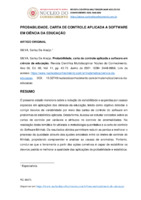 PROBABILIDADE, CARTA DE CONTROLE APLICADA A SOFTWARE EM CIÊNCIA DA EDUCAÇÃO
PROBABILIDADE, CARTA DE CONTROLE APLICADA A SOFTWARE EM CIÊNCIA DA EDUCAÇÃO O presente estudo menciona sobre a redução de variabilidade e as perdas por causas
especiais em aplicações das ciências da educação, tendo como objetivo detectar e
corrigir desvios de variabilidade por meio das cartas de controle do software em
problemas de estatística aplicada. Desta forma, buscou-se estudar conceitos sobre as
cartas de controle por variáveis e atributos no controle de anormalidades. Na
realização desta temática foi utilizada a metodologia quantitativa e a carta de controle
do Software Minitab. Os resultados obtidos permitiram reduzir as perdas e melhorar o
processo da qualidade através dos ajustes amostrais entre os limites de controle do
Minitab, propiciando compreender e analisar as causas de anomalias. Portanto,
conclui-se que a ferramenta a partir das ações corretivas é capaz de estabilizar os
desvios padrão e melhorar a qualidade das aplicações de probabilidade e estatística
-
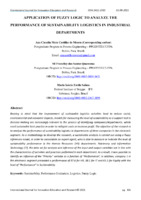 APPLICATION OF FUZZY LOGIC TO ANALYZE THE PERFORMANCE OF SUSTAINABILITY LOGISTICS IN INDUSTRIAL DEPARTMENTS
APPLICATION OF FUZZY LOGIC TO ANALYZE THE PERFORMANCE OF SUSTAINABILITY LOGISTICS IN INDUSTRIAL DEPARTMENTS Bearing in mind that the improvement of sustainable logistics activities tend to reduce social,
environmental and economic impacts, models for measuring the level of sustainability as a support tool in
decision making are increasingly relevant to the process of identifying companies/departments, which
need sustainable best practice in order to mitigate costs or increase profit. The objective of the research is
to analyze the performance of sustainability logistics in departments of three companies in the electronic
segment. As a methodology to develop the research, a sustainable analysis is carried out using a Fuzzy
inferences model, in order to consolidate an expert agent, who is able to measure or indicate the level of
sustainability performance in the Human Resources (HR) departments. Patrimony and Information
Technology (IT), the data set for analysis and inference of the input and output variables are in line with
the characteristics of activities and practices performed in each department. As a result, it was possible to
identify an influence of the “Priority” variable as a function of “Performance”, in addition, company 1 in
the electronic segment presented a performance of 87.6 for HR, 88.1 for IT and 65.5 for Equity with the
level of “Performance” in Sustainability
-
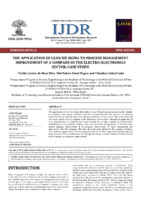 THE APPLICATION OF LEAN SIX SIGMA TO PROCESS MANAGEMENT IMPROVEMENT OF A COMPANY IN THE ELECTRO-ELECTRONICS SECTOR: CASE STUDY
THE APPLICATION OF LEAN SIX SIGMA TO PROCESS MANAGEMENT IMPROVEMENT OF A COMPANY IN THE ELECTRO-ELECTRONICS SECTOR: CASE STUDY The application of Lean Six Sigma philosophy or Lean Manufacturing has good results obtained
in companies when using techniques and tools continuously with the objective of obtaining
improvements by reducing waste and reducing variability. In this context, this work shows the
case study carried out in a company in the electronics sector of how. through the application of
Lean manufacturing, it obtained good results through the monthly measurements and analysis
methodology of Lean maturity, creation of the Lean committee, and application of the tools, value
stream mapping, improvement of 5S program, improvement of visual management and
application of the ideas program. The study shows the gains obtained in the company reaching a
Lean maturity improvement of 42,5% going from Bronze to Silver stage and manufacturing cost
improvement of 30%, in addition we can highlight the change in culture mindset that has occurred
in the company on continuous improvement.
-
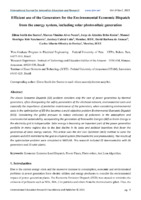 Efficient use of the Generators for the Environmental Economic Dispatch from the energy system, including solar photovoltaic generation
Efficient use of the Generators for the Environmental Economic Dispatch from the energy system, including solar photovoltaic generation The classic Economic Dispatch (ED) problem considers only the cost of power generation by thermal
generators, often disregarding the safety parameters of the electrical network, environmental costs and
especially the importance of predictive maintenance of the generators, when considering environmental
costs in the optimization of ED this becomes a multi-objective problem Environmental Economic Dispatch
(EED). Considering the global pressure to reduce emissions of pollutants in the atmosphere and
environmental sustainability, incorporating the generation of Renewable Energies (RE) or Green Energy in
the electricity grid is indispensable. Solar energy is becoming an important part of the power generation
portfolio in many regions due to the fast decline in its costs and political incentives that favor the
generation of clean energy sources. This article uses the Ant Lion Optimizer (ALO) method to solve the
problem and EED restricted to the grid in a hybrid system (thermoelectric and photovoltaic). The results of
the optimization problem were simulated in MATLAB. This research included 01 thermoelectric with 06
generators and 13 solar plants.
-
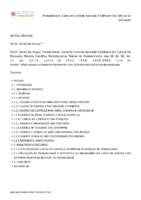 Probabilidade, Carta De Controle Aplicada A Software Em Ciência Da Educação
Probabilidade, Carta De Controle Aplicada A Software Em Ciência Da Educação O presente estudo menciona sobre a redução de variabilidade e as perdas por causas
especiais em aplicações das ciências da educação, tendo como objetivo detectar e corrigir
desvios de variabilidade por meio das cartas de controle do software em problemas de
estatística aplicada. Desta forma, buscou-se estudar conceitos sobre as cartas de controle
por variáveis e atributos no controle de anormalidades. Na realização desta temática foi
utilizada a metodologia quantitativa e a carta de controle do Software Minitab. Os resultados
obtidos permitiram reduzir as perdas e melhorar o processo da qualidade através dos ajustes
amostrais entre os limites de controle do Minitab, propiciando compreender e analisar as
causas de anomalias. Portanto, conclui-se que a ferramenta a partir das ações corretivas é
capaz de estabilizar os desvios padrão e melhorar a qualidade das aplicações de
probabilidade e estatística.
-
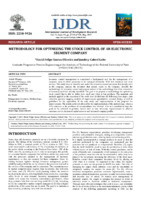 METHODOLOGY FOR OPTIMIZING THE STOCK CONTROL OF AN ELECTRONIC SEGMENT COMPANY
METHODOLOGY FOR OPTIMIZING THE STOCK CONTROL OF AN ELECTRONIC SEGMENT COMPANY Inventory control management is considered a fundamental tool for the management of a
company, since it allows processes to be managed efficiently. With less resources and more
savings. This study aims to: identify and model the inventory control processes that already exist
in the company, analyze the inventory that already exists in the company, describe the
methodology for inventory control and propose actions of the methodology that allow corrections
of inventory activities already identified. The goal is to propose a methodology for optimizing
stock control that is able to define how much and when to buy products. The materials and
methods applied in the execution of the work were divided into the following four stages: data
collection, process mapping, analysis of improvement opportunities, research design, as well as
guidelines for the application of the case study and implementation of the proposal for
improvements. The results achieved allowed for the implementation of the methodology, where a
30% reduction in the problems of non-attendance was allowed. Also as a contribution were the
goals to be achieved as positive factors such as lean inventory, improvements to efficient
customer service, increased capital turnover and increased company profits
-
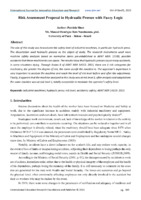 Risk Assessment Proposal in Hydraulic Presses with Fuzzy Logic
Risk Assessment Proposal in Hydraulic Presses with Fuzzy Logic The aim of this study was to evaluate the safety level of industrial machines, in particular hydraulic press.
The dissertation used hydraulic presses as the object of study. The research instruments used were
machine safety analyzes based on normative items pre-established in ABNT NBR: 12100, possible
accidents that these machineries can cause. The results show that hydraulic presses cause many accidents,
in some situations dying. Through Annex B of ABNT NBR 14153: 2013, there are 4 risk categories for
machinery, the greater the degree of risk, the more unsafe the machine is. The appraiser's experience is
very important to analyze the machine and reach the level of risk level before and after the adjustment.
Finally, it appears that the machine analyzed in this study was at risk level 3, after analysis and adaptations
the same machine was at risk level 1, totally acceptable to maintain the operator's safety level.
-
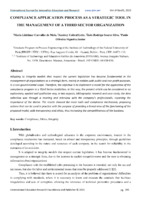 Compliance application process as a strategic tool in the management of a third sector organization
Compliance application process as a strategic tool in the management of a third sector organization Adapting to integrity models that respect the current legislation has become fundamental in the management of organizations as a strategic form, mainly in entities with public and non-profit purposes, in a non-governmental scope. Therefore, the objective is to implement a model for the application of the compliance program in a Third Sector institution. In this way, the present article can be considered in an exploratory, applied and qualitative way, in two aspects, bibliographic research and case study, the data collection was through a meeting and interview with the company's professionals, reporting the importance of the theme. The results showed the main tools and compliance mechanism, proposing actions that can be used in practice with the purpose of providing a broad view of the functioning of the proposed model, with transparency and ethics, thus increasing the competitiveness of the business.
-
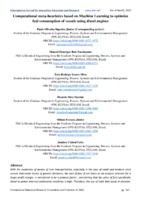 COMPUTATIONAL META-HEURISTICS BASED ON MACHINE LEARNING TO OPTIMIZE FUEL CONSUMPTION OF VESSELS USING DIESEL ENGINES
COMPUTATIONAL META-HEURISTICS BASED ON MACHINE LEARNING TO OPTIMIZE FUEL CONSUMPTION OF VESSELS USING DIESEL ENGINES With the expansion of means of river transportation, especially in the case of small and medium-sized
vessels that make routes of greater distances, the cost of fuel, if not taken as an analysis criterion for a
larger profit margin, is considered to be a primary factor , considering that the value of fuel specifically
diesel to power internal combustion machines is high. Therefore, the use of tools that assist in decision
With the expansion of means of river transportation, especially in the case of small and medium-sized
vessels that make routes of greater distances, the cost of fuel, if not taken as an analysis criterion for a
larger profit margin, is considered to be a primary factor , considering that the value of fuel specifically
diesel to power internal combustion machines is high. Therefore, the use of tools that assist in decision
-
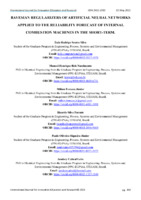 BAYESIAN REGULARIZERS OF ARTIFICIAL NEURAL NETWORKS APPLIED TO THE RELIABILITY FORECAST OF INTERNAL COMBUSTION MACHINES IN THE SHORT-TERM
BAYESIAN REGULARIZERS OF ARTIFICIAL NEURAL NETWORKS APPLIED TO THE RELIABILITY FORECAST OF INTERNAL COMBUSTION MACHINES IN THE SHORT-TERM Predictive as well as preventive maintenance are tools of maintenance programs that aim to increase or
maintain the life expectancy of an equipment through computational techniques and tools. Bearing in
mind that the power generation industry has a high maintenance rate with machines and / or electric
generators stopped, this research aims to develop a computational model for predicting the Reliability Key
Performance Indicator (KPI) to identify how available the equipment will be in a time span of 22 days, for
this the methodology to be used will be based on analyzes and tests of artificial neural network (ANN)
architectures using the Bayesian Regularizers training algorithm, alternating the transfer functions in the
layers hidden to find the best state of convergence and the minimum Root Mean Square Error (RMSE)
value calculated between the real and simulated outputs. According to the results obtained by the training,
validation and test steps, the algorithm presented a RMSE rate of 0.0000104202 and a 99.9% correlation
between the real and simulated values, thus the model is able to identify which machine will have the
greatest efficiency and less efficiency within the defined time span.
-
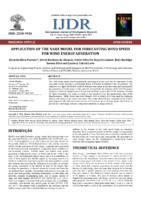 APPLICATION OF THE NARX MODEL FOR FORECASTING WIND SPEED FOR WIND ENERGY GENERATION
APPLICATION OF THE NARX MODEL FOR FORECASTING WIND SPEED FOR WIND ENERGY GENERATION The wind energy matrix has been gradually increasing in recent years and its importance for the
renewable energy industry is increasingly linked to benefits in relation to the environment. The
objective is to apply the NARX model to forecast wind speed in the short term and consequently
the generation of wind energy. In the materials and methods, the database of the SONDA project
(System of National Organization of Environmental Data) organized by INPE (National Institute
for Space Research) was used, in which it was decided to use the anemometric data of the
Brasília station - BRB, where data from February 2005 to March 2019 were used for validation
training and testing of the model developed. The results obtained were characterized by a better
performance for the short-term time horizon of 10 minutes up to 10 steps ahead, which helps to
provide the wind energy industry with greater reliability in energy delivery
-
 INTEGRATED PURCHASE MANAGEMENT: A PROCESS MODEL FOR SUPPLIER SELECTION BASED ON FUZZY LOGIC
INTEGRATED PURCHASE MANAGEMENT: A PROCESS MODEL FOR SUPPLIER SELECTION BASED ON FUZZY LOGIC The search for competitive advantage through the interconnection of organizational processes
allows the reduction of time and expenses for companies. Therefore, this study had as main
objective to propose strategies that allow to find good practices for these actions, whose main
objective was to present a model for the selection process of suppliers based on fuzzy logic to
improve activities. In this context, integrated purchasing management, supplier selection, fuzzy
logic, its pertinence variables and the use of rules established to meet the procurement procedures
of a foundation to support Research, Extension and R&D. Finally, the result is a final assessment
of suppliers, using the fuzzy inference method developed in the Matlab® software, in the Fuzzy
Logic Toolbox environment, in the Mamdani model, taking into account the social and economic
criteria for a possible purchase of a very relevant electronic product in the institution, allowing
this tool to become practical and applicable to the needs of the sector. After data obtained, it was
concluded that the model proved to be very efficient, presenting a minimum difference from one
supplier to the other, where the first place obtained a score of 2.06 more in relation to the selected
room, seen as the longest distance in compared to the other classifieds, and it is important to
continue the relationship with them in future acquisitions, one must also adopt the use of tools to
recover those that did not show good results, in addition to the development of new suppliers.
taking into account the social and economic criteria for a possible purchase of a very relevant
electronic product in the institution, allowing this tool to become practical and applicable to the
needs of the sector.
-
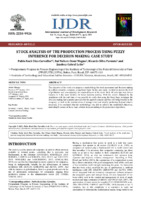 STOCK ANALYSIS OF THE PRODUCTION PROCESS USING FUZZY INFERENCE FOR DECISION MAKING: CASE STUDY
STOCK ANALYSIS OF THE PRODUCTION PROCESS USING FUZZY INFERENCE FOR DECISION MAKING: CASE STUDY The objective of the work is to propose a methodology for stock assessment and decision making
in a phyto cosmetics company, using fuzzy logic. In this case study, we tried to answer the level
of production and, consequently, the reasonableness of the stock. Such AI technique was chosen
because it is the most suitable for better decision making. With the results obtained by the
simulation with the real data, it was possible to verify that using the fuzzy logic technique the
decision making had a greater precision for the applied scenario and this will bring benefits to the
company, as well as the minimization of storage costs and weekly production beyond what is
necessary. It is concluded that the methodology was able to achieve the established objectives,
indicating by means of fuzzy logic a better decision making in the production of products.
-
PRESERVAR BRINCANDO: HORTA ESCOLAR ORGÂNICA COM GARRAFA PET
A presente pesquisa teve como objetivo implantar uma Horta Escolar Orgânica utilizando
Garrafas Pet, como ferramenta de ensino na Educação Ambiental com crianças de 3 a 5 anos
da Creche Municipal Sandra Braga no município de Cacau Pirêra no Estado do Amazonas. Para
alcançar o objetivo primeiramente foi realizado uma reunião com os pais/responsáveis de 30
crianças do 2o período do ensino infantil na faixa etária de 3 a 5 anos do turno matutino e
vespertino que aceitaram o convite da direção da escola. Foi exposto objetivo do projeto,
entregue e explicado o TCLE e também foi entregue aos mesmos o questionário A contendo
duas perguntas sobre as preferências alimentares de seus filhos e a importância da horta
escolar. Após foi discutido com a comunidade escolar temas relativos à adubação do solo, ao
cultivo de hortaliças e a importância da reciclagem das garrafas PET. Estabelecido o local para
a implantação da horta conforme a disponibilidade de sol, água, condições de terreno e proteção
de ventos fortes e frios, sendo implementada em área retangular, contendo 4 canteiros sendo
cada canteiro medindo 1,00 metro de comprimento por 40 centímetros de largura e espaçamento
de um canteiro a outro de 50 centímetro e utilizados 56 garrafas PET que foram confeccionados
pelas crianças e pelos pais/responsáveis. Sobre a horta foram instalados sombrite, para evitar o
excesso de exposição das hortaliças ao sol e à chuva. Os grupos de crianças, sob a coordenação
dos professores e coordenadores da creche, deram sequência ao plantio das mudas e sementes
de alface, couve, cebolinha e chicória. Durante tal ação, questões relativas aos aspectos físicos,
químicos e biológicos, e verificação sobre o estado geral do solo encontrado na área dos
canteiros foram levantadas, sendo constatada a necessidade de uso de matéria orgânica
(compostagem e esterco) para melhorar a qualidade das hortaliças. Em sala, foram planejados
as datas e os horários de regas dos canteiros, e distribuídos entre os grupos de crianças. Depois
do plantio, as hortaliças foram colhidas, preparadas e servidas às crianças na merenda. Após a
atividade do plantio foi entregue aos professores das turmas participantes, o questionário B onde
foi relacionado as atividades que as crianças mais gostaram e o que elas não gostaram referente
aos cuidados com a horta. As atividades resultaram na motivação das crianças contribuindo com
seu rendimento escolar e consciência sobre o meio ambiente.
-
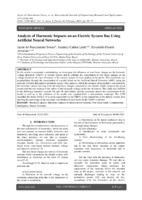 Analysis of Harmonic Impacts on an Electric System Bus Using Artificial Neural Networks
Analysis of Harmonic Impacts on an Electric System Bus Using Artificial Neural Networks In this article is presented a methodology to investigate the influence on non-linear charges on the harmonic
voltage distortion (THDV) in electric system and to estimate the contribution of non-linear charges on the
voltage distortion of a bus of interest of the electric system of force studied in the article. This estimation was
accomplished through the construction of a model based on the Artificial Neural Networks (ANN), using the
software AAQEE dedicated to electricity quality (EQ) analysis, which the entrance of the model is constituted by
the harmonic current deriving from the non-linear charges connected to two feeders which compose the actual
system and the exit relating to the values of the harmonic voltage in the bus of interest. This study was fulfilled
to the following harmonic currents 5th and 7th individually, and the necessary data to the construction of the
model as well as to the validation of the results was acquired from a measurement campaign. The ANN
identified the feeder DIAL2-19 as most responsible for the THDV in the studied bus of the electric system, then
showing the percentage of the harmonic contribution of each feeder to the THDV in the bus
-
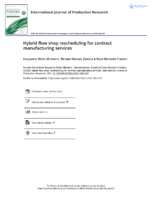 Hybrid flow shop rescheduling for contract manufacturing services
Hybrid flow shop rescheduling for contract manufacturing services Several approaches for strategic and tactical integration of supply chains considering the demand
management process have been proposed in the literature. However, in the context of Industry
4.0, there is a lack of studies related to the scheduling and rescheduling process integrating industries on the operational level. This paper proposes a novel hybrid flow shop rescheduling procedure
to address the integration, on the operational level, of a contract manufacturer, who handles production execution and inventory control, and their industrial customers, who are in charge of the
delivery planning process. The research question emergedfrom the empirical problem of connecting
a contract manufacturer with its industrial customers. In alignment with the findings in the literature review, based on an updated conceptual model, a real hybrid flow shop was modelled using
a multi-method approach that combines discrete event and agent-based simulation. The results
show improvements in overall production and delivery performance. One can say that this is the
first time that a production rescheduling problem is handled considering industries’ integration at
the operational level. Even though the primary motivation of this research was to solve a production
rescheduling issue in a Contract Manufacturer, the developed approach allows application in any
B2B partnership.
 COMPOSTING MODEL WITH THE REUSE OF ORGANIC WASTE IN RURAL SCHOOLS School institutions become producers of organic waste as a result of the daily consumption of school meals offered to students during the school year. An alternative, so that this material is not incorrectly released into the environment, is the implementation of a composting model that will reuse organic waste, generating humus, which will serve as fertilizer for the implementation of a vegetable garden in the school in the rural area. This work aims to propose a composter model in a School in the Rural Area of Manaus for the reuse of organic waste, to develop a prototype of composter for the production of humic substances and mineral nutrients for the creation of gardens, to prepare the manual with guidelines for the correct and sustainable management of the composting plant and the school garden and implementing the garden system through the composting process using school organic waste. The work is a case study that proposes to implement a prototype of compost for the production of humic substances and mineral nutrients for the construction of a school garden. It is intended that the proposal raises the awareness of the school community for the correct management and reuse of solid waste generated by the school and arouse in students and teachers the interest in environmental education and behavior change for the preservation of the environment in which they live
COMPOSTING MODEL WITH THE REUSE OF ORGANIC WASTE IN RURAL SCHOOLS School institutions become producers of organic waste as a result of the daily consumption of school meals offered to students during the school year. An alternative, so that this material is not incorrectly released into the environment, is the implementation of a composting model that will reuse organic waste, generating humus, which will serve as fertilizer for the implementation of a vegetable garden in the school in the rural area. This work aims to propose a composter model in a School in the Rural Area of Manaus for the reuse of organic waste, to develop a prototype of composter for the production of humic substances and mineral nutrients for the creation of gardens, to prepare the manual with guidelines for the correct and sustainable management of the composting plant and the school garden and implementing the garden system through the composting process using school organic waste. The work is a case study that proposes to implement a prototype of compost for the production of humic substances and mineral nutrients for the construction of a school garden. It is intended that the proposal raises the awareness of the school community for the correct management and reuse of solid waste generated by the school and arouse in students and teachers the interest in environmental education and behavior change for the preservation of the environment in which they live Development of an Intelligent Mobile Robot Prototype for Indoor Material Transportation This article is focused on methods, techniques and tools to assist the development of products and robots that need to work with precision in indoor environments, besides presenting the main technologies related to the subject, with their respective advantages, disadvantages, challenges. Finally, a prototype of a mobile robot will be proposed and developed. Self-driving vehicles have become part of Industry 4.0. The Fourth Revolution is present in all stages of manufacturing a product, with benefits for safety, profitability, quality, assembly and worker well-being. Intelligent mobile robots have the ability to move in predetermined places, autonomously and without running the risk of colliding with other robots or people, being able to reprogram their trajectories, no longer having the need to place markers when along its route. They are able to carry heavy loads, carry out unhealthy tasks and work 24 hours a day, 7 days a week.
Development of an Intelligent Mobile Robot Prototype for Indoor Material Transportation This article is focused on methods, techniques and tools to assist the development of products and robots that need to work with precision in indoor environments, besides presenting the main technologies related to the subject, with their respective advantages, disadvantages, challenges. Finally, a prototype of a mobile robot will be proposed and developed. Self-driving vehicles have become part of Industry 4.0. The Fourth Revolution is present in all stages of manufacturing a product, with benefits for safety, profitability, quality, assembly and worker well-being. Intelligent mobile robots have the ability to move in predetermined places, autonomously and without running the risk of colliding with other robots or people, being able to reprogram their trajectories, no longer having the need to place markers when along its route. They are able to carry heavy loads, carry out unhealthy tasks and work 24 hours a day, 7 days a week. INJECTION MOLDING MACHINES ADEQUANCY TO REGULATORY STANDARDS NR 17 AND NR 35 Safety risks with plastic injection machines represent a serious problem in the plastic production chain. Even with the implementation of ABNT NBR 13536/95 to establish the minimum safety requirements for injection molding machines and its subsequent inclusion in the regulatory standard NR 12, there are risks related to work at heights and ergonomics that are not properly specified, especially during maintenance activities of the resin hopper loader or resin color change-over. To mitigate such risks, the present work proposes to develop two concepts for safety adaptation of injection machines to NR 17 and NR 35, based on their size and clamping force, being the first a prototype of an access ladder and metallic support of the resin hopper loader, and the second prototype being a safety platform prototype at the top of the injection machine, so that the operator could have 360º access to the resin hopper loader. After the design, construction and implementation of the two prototypes, it was observed the compliance with the NR 17 and NR 35, as well as improvements in productivity, safety, ergonomics and morale of the operators in the production process. The present work also exposes the costs and characteristics of the materials used.
INJECTION MOLDING MACHINES ADEQUANCY TO REGULATORY STANDARDS NR 17 AND NR 35 Safety risks with plastic injection machines represent a serious problem in the plastic production chain. Even with the implementation of ABNT NBR 13536/95 to establish the minimum safety requirements for injection molding machines and its subsequent inclusion in the regulatory standard NR 12, there are risks related to work at heights and ergonomics that are not properly specified, especially during maintenance activities of the resin hopper loader or resin color change-over. To mitigate such risks, the present work proposes to develop two concepts for safety adaptation of injection machines to NR 17 and NR 35, based on their size and clamping force, being the first a prototype of an access ladder and metallic support of the resin hopper loader, and the second prototype being a safety platform prototype at the top of the injection machine, so that the operator could have 360º access to the resin hopper loader. After the design, construction and implementation of the two prototypes, it was observed the compliance with the NR 17 and NR 35, as well as improvements in productivity, safety, ergonomics and morale of the operators in the production process. The present work also exposes the costs and characteristics of the materials used. Implementation of a Supervisory System in Electric Power Generating Units of Isolated Systems Installed In Municipalities of the Amazonas State This research consists of an exploratory research carried out by monitoring the maintenance activities carried out in the Thermoelectric Power Plants installed in the cities of the State of Amazonas, with the objective of implementing a monitoring system for electrical quantities coming from engines, also called Engenies Electric Power. This is a field research with qualitative approaches, taking into account the implementation of an automated system to capture the variations in electrical quantities (Voltage, Current, Power and Power Factor) of these energy generating units. The capture of these data, which are the variations of electrical quantities, occurs with the use of PLC, transducers, Modem, among other equipment, which are stored in a database (computer) that using a Supervisory System modeled for this purpose, providing the visualization of these data, in real time, in a friendly and interactive interface. From the monitoring of these data, via a Supervisory System, and with the use of data manipulation tools from the SCADA system, an interface for the generation of graphics was modeled, which significantly contributed to the interpretation of these data. And in addition, make it available remotely, to everyone involved in the activities of the plants, thus being able to access the Supervisory System from anywhere in the world, through the internet.
Implementation of a Supervisory System in Electric Power Generating Units of Isolated Systems Installed In Municipalities of the Amazonas State This research consists of an exploratory research carried out by monitoring the maintenance activities carried out in the Thermoelectric Power Plants installed in the cities of the State of Amazonas, with the objective of implementing a monitoring system for electrical quantities coming from engines, also called Engenies Electric Power. This is a field research with qualitative approaches, taking into account the implementation of an automated system to capture the variations in electrical quantities (Voltage, Current, Power and Power Factor) of these energy generating units. The capture of these data, which are the variations of electrical quantities, occurs with the use of PLC, transducers, Modem, among other equipment, which are stored in a database (computer) that using a Supervisory System modeled for this purpose, providing the visualization of these data, in real time, in a friendly and interactive interface. From the monitoring of these data, via a Supervisory System, and with the use of data manipulation tools from the SCADA system, an interface for the generation of graphics was modeled, which significantly contributed to the interpretation of these data. And in addition, make it available remotely, to everyone involved in the activities of the plants, thus being able to access the Supervisory System from anywhere in the world, through the internet. Swot Analysis Implemented with Fuzzy Inference to Support Decision Making Current market conditions require organizations to understand the business environment in order to achieve strategic planning and decision-making processes. An organization's competitive advantage is associated with an understanding of how to determine the potential of these companies when examining internal and external conditions (insertions) and the effort to meet customer needs. Among the many tools that contribute to this understanding, the SWOT analysis stands out, which can assist organizations to better understand the internal and external environment and formulate strategic plans in a collaborative way. This work aimed to implement an evaluation model for SWOT analysis using fuzzy inference methods. The adopted methodology started from a survey on the internal and external characteristics of the organization, definition of the linguistic criteria of the SWOT matrix, correlation between the variables found and elaboration of the fuzzy inference system for crossing the inputs. The approach proposed by the Fuzzy Inference model for the SWOT matrix proved to be simplified and efficient for a better collection of information that allows the prediction of the future environment, enabling reasoned strategies resulting from the model presented
Swot Analysis Implemented with Fuzzy Inference to Support Decision Making Current market conditions require organizations to understand the business environment in order to achieve strategic planning and decision-making processes. An organization's competitive advantage is associated with an understanding of how to determine the potential of these companies when examining internal and external conditions (insertions) and the effort to meet customer needs. Among the many tools that contribute to this understanding, the SWOT analysis stands out, which can assist organizations to better understand the internal and external environment and formulate strategic plans in a collaborative way. This work aimed to implement an evaluation model for SWOT analysis using fuzzy inference methods. The adopted methodology started from a survey on the internal and external characteristics of the organization, definition of the linguistic criteria of the SWOT matrix, correlation between the variables found and elaboration of the fuzzy inference system for crossing the inputs. The approach proposed by the Fuzzy Inference model for the SWOT matrix proved to be simplified and efficient for a better collection of information that allows the prediction of the future environment, enabling reasoned strategies resulting from the model presented Semiautomatedsystem for optimizing thermal comfort and reducing rice waste in the poultry breeding process of small producers from the interior of the Amazon region In the Amazon region, the reality of the conventional laying poultry production chain consists of farms with structures that are inferior to those in other regions, with a massive presence of small poultry farmers, without a water, food and air conditioning automation system. The need for improvements in the poultry process that the small producer needs to produce can be linked to the relationship of implementing technology for monitoring equipment or systems. Therefore, the motivation of this study was the creation of a semi-automated system to optimize the thermal comfort of birds and reduce feed waste in the laying poultry production process for small producers in the interior of the Amazon region in order to reduce mortality and maximize the profit. The methodology designated for the construction of this research was based on the nature of applied research, with a view to the qualitative-quantitative approach, through technical procedures of a case study. After assembly of the semi-automated system for feeding, adding the total savings for feed consumption would be 1964.20 kg of feed, in reais it would be R$ 7,856.80. And for the ambiance system, we have savings on the energy bill of 60.94 reais a month and 731.31 reais a year. The semi-automated systems suggested for small poultry farmers in the Amazon region theoretically fulfill their objective, both for the improvement of waste and for the provision of animal welfare and increased profitability
Semiautomatedsystem for optimizing thermal comfort and reducing rice waste in the poultry breeding process of small producers from the interior of the Amazon region In the Amazon region, the reality of the conventional laying poultry production chain consists of farms with structures that are inferior to those in other regions, with a massive presence of small poultry farmers, without a water, food and air conditioning automation system. The need for improvements in the poultry process that the small producer needs to produce can be linked to the relationship of implementing technology for monitoring equipment or systems. Therefore, the motivation of this study was the creation of a semi-automated system to optimize the thermal comfort of birds and reduce feed waste in the laying poultry production process for small producers in the interior of the Amazon region in order to reduce mortality and maximize the profit. The methodology designated for the construction of this research was based on the nature of applied research, with a view to the qualitative-quantitative approach, through technical procedures of a case study. After assembly of the semi-automated system for feeding, adding the total savings for feed consumption would be 1964.20 kg of feed, in reais it would be R$ 7,856.80. And for the ambiance system, we have savings on the energy bill of 60.94 reais a month and 731.31 reais a year. The semi-automated systems suggested for small poultry farmers in the Amazon region theoretically fulfill their objective, both for the improvement of waste and for the provision of animal welfare and increased profitability Work Safety: Fuzzy Inference Model Specification for Evaluation of Heat Agent This research proposes an inference model fuzzy to analyses hazardous environmental work conditions, specifically insalubrious work conditions relevant for heat risk to support the safety engineers for making decisions. The article presents a study that consists of a fuzzy inference model specification for the evaluation of heat agents. The structure of model fuzzy used are inputs temperature and metabolic rate, while the output is work environment condition that could be salubrious or insalubrious. Through, the inference method Mamdani and rules established according to Brazil legislation about heat, Occupational Hygiene Standard 06, the proposed model can determine the work conditions about the heat. The validation process is done in an industry from the Industrial Pole of Manaus, therefor all the process necessary for preparations to use the proposed model is described to obtain all the variables necessary in the field. As a result, the proposed model got the correct classification of work environment conditions with pertinent results according to current legislation and technical expertise
Work Safety: Fuzzy Inference Model Specification for Evaluation of Heat Agent This research proposes an inference model fuzzy to analyses hazardous environmental work conditions, specifically insalubrious work conditions relevant for heat risk to support the safety engineers for making decisions. The article presents a study that consists of a fuzzy inference model specification for the evaluation of heat agents. The structure of model fuzzy used are inputs temperature and metabolic rate, while the output is work environment condition that could be salubrious or insalubrious. Through, the inference method Mamdani and rules established according to Brazil legislation about heat, Occupational Hygiene Standard 06, the proposed model can determine the work conditions about the heat. The validation process is done in an industry from the Industrial Pole of Manaus, therefor all the process necessary for preparations to use the proposed model is described to obtain all the variables necessary in the field. As a result, the proposed model got the correct classification of work environment conditions with pertinent results according to current legislation and technical expertise Optimization of the transfer process to the Municipalities and the Federal District - DF, of Law 13,240, of December 30, 2015 The need for continuous improvement in the transfer process to municipalities and the Federal District in compliance with the legislation in art. 27 of Law No. 13,240, of December 30, 2015, included the wording of art. 6-B in Decree-Law No. 2,398, of December 21, 1987, establishing the obligation for the Union, through the Secretariat for Coordination and Governance of the Union's Heritage - SPU, to transfer the corresponding to the Municipalities and the Federal District - DF to 20% (twenty percent) of the annual collections of the previous year referring to Forum, Occupancy Fee and Laudemium, charged for the use of those properties located in the municipalities and in the DF and art. 17 of Law No. 13,240, of 2015, and 16-G of Law No. 13,465, of July 11, 2017, likewise determined the transfer of 20% of equity income arising from the sale of Federal properties that are registered in occupation and, also, the remission of jurisdiction of the real estate under a lease, respectively, always observing the location of the real estate. The primary interest is to examine the transfer process in the last 5 (five) years and optimize, analyze the failures of the transfer process, as well as quantify the amounts not transferred to the states.
Optimization of the transfer process to the Municipalities and the Federal District - DF, of Law 13,240, of December 30, 2015 The need for continuous improvement in the transfer process to municipalities and the Federal District in compliance with the legislation in art. 27 of Law No. 13,240, of December 30, 2015, included the wording of art. 6-B in Decree-Law No. 2,398, of December 21, 1987, establishing the obligation for the Union, through the Secretariat for Coordination and Governance of the Union's Heritage - SPU, to transfer the corresponding to the Municipalities and the Federal District - DF to 20% (twenty percent) of the annual collections of the previous year referring to Forum, Occupancy Fee and Laudemium, charged for the use of those properties located in the municipalities and in the DF and art. 17 of Law No. 13,240, of 2015, and 16-G of Law No. 13,465, of July 11, 2017, likewise determined the transfer of 20% of equity income arising from the sale of Federal properties that are registered in occupation and, also, the remission of jurisdiction of the real estate under a lease, respectively, always observing the location of the real estate. The primary interest is to examine the transfer process in the last 5 (five) years and optimize, analyze the failures of the transfer process, as well as quantify the amounts not transferred to the states. PROPOSAL FOR THE DEVELOPMENT OF BURN-IN INLINE Advanced manufacturing promises to significantly impact the economy in various branches and industrial segments, such as metallurgy and agribusiness. Therefore, the aim is to develop a new product implemented at the company Transire, an automated system for storage in a controlled temperature environment, testing and test monitoring in real-time of its final products. Thus, this article can be considered exploratory, applied, and qualitative under the aspects of bibliographical research and case studies. Data collection was through meetings with company professionals, technical visits, and research on the importance of the topic. The results showed that the main stages of development of the Burn-In Inline were validated and that studies of production capacity associated with these developments can generate factory modernization and greater competitiveness among companies in the field.
PROPOSAL FOR THE DEVELOPMENT OF BURN-IN INLINE Advanced manufacturing promises to significantly impact the economy in various branches and industrial segments, such as metallurgy and agribusiness. Therefore, the aim is to develop a new product implemented at the company Transire, an automated system for storage in a controlled temperature environment, testing and test monitoring in real-time of its final products. Thus, this article can be considered exploratory, applied, and qualitative under the aspects of bibliographical research and case studies. Data collection was through meetings with company professionals, technical visits, and research on the importance of the topic. The results showed that the main stages of development of the Burn-In Inline were validated and that studies of production capacity associated with these developments can generate factory modernization and greater competitiveness among companies in the field. PROBABILIDADE, CARTA DE CONTROLE APLICADA A SOFTWARE EM CIÊNCIA DA EDUCAÇÃO O presente estudo menciona sobre a redução de variabilidade e as perdas por causas especiais em aplicações das ciências da educação, tendo como objetivo detectar e corrigir desvios de variabilidade por meio das cartas de controle do software em problemas de estatística aplicada. Desta forma, buscou-se estudar conceitos sobre as cartas de controle por variáveis e atributos no controle de anormalidades. Na realização desta temática foi utilizada a metodologia quantitativa e a carta de controle do Software Minitab. Os resultados obtidos permitiram reduzir as perdas e melhorar o processo da qualidade através dos ajustes amostrais entre os limites de controle do Minitab, propiciando compreender e analisar as causas de anomalias. Portanto, conclui-se que a ferramenta a partir das ações corretivas é capaz de estabilizar os desvios padrão e melhorar a qualidade das aplicações de probabilidade e estatística
PROBABILIDADE, CARTA DE CONTROLE APLICADA A SOFTWARE EM CIÊNCIA DA EDUCAÇÃO O presente estudo menciona sobre a redução de variabilidade e as perdas por causas especiais em aplicações das ciências da educação, tendo como objetivo detectar e corrigir desvios de variabilidade por meio das cartas de controle do software em problemas de estatística aplicada. Desta forma, buscou-se estudar conceitos sobre as cartas de controle por variáveis e atributos no controle de anormalidades. Na realização desta temática foi utilizada a metodologia quantitativa e a carta de controle do Software Minitab. Os resultados obtidos permitiram reduzir as perdas e melhorar o processo da qualidade através dos ajustes amostrais entre os limites de controle do Minitab, propiciando compreender e analisar as causas de anomalias. Portanto, conclui-se que a ferramenta a partir das ações corretivas é capaz de estabilizar os desvios padrão e melhorar a qualidade das aplicações de probabilidade e estatística APPLICATION OF FUZZY LOGIC TO ANALYZE THE PERFORMANCE OF SUSTAINABILITY LOGISTICS IN INDUSTRIAL DEPARTMENTS Bearing in mind that the improvement of sustainable logistics activities tend to reduce social, environmental and economic impacts, models for measuring the level of sustainability as a support tool in decision making are increasingly relevant to the process of identifying companies/departments, which need sustainable best practice in order to mitigate costs or increase profit. The objective of the research is to analyze the performance of sustainability logistics in departments of three companies in the electronic segment. As a methodology to develop the research, a sustainable analysis is carried out using a Fuzzy inferences model, in order to consolidate an expert agent, who is able to measure or indicate the level of sustainability performance in the Human Resources (HR) departments. Patrimony and Information Technology (IT), the data set for analysis and inference of the input and output variables are in line with the characteristics of activities and practices performed in each department. As a result, it was possible to identify an influence of the “Priority” variable as a function of “Performance”, in addition, company 1 in the electronic segment presented a performance of 87.6 for HR, 88.1 for IT and 65.5 for Equity with the level of “Performance” in Sustainability
APPLICATION OF FUZZY LOGIC TO ANALYZE THE PERFORMANCE OF SUSTAINABILITY LOGISTICS IN INDUSTRIAL DEPARTMENTS Bearing in mind that the improvement of sustainable logistics activities tend to reduce social, environmental and economic impacts, models for measuring the level of sustainability as a support tool in decision making are increasingly relevant to the process of identifying companies/departments, which need sustainable best practice in order to mitigate costs or increase profit. The objective of the research is to analyze the performance of sustainability logistics in departments of three companies in the electronic segment. As a methodology to develop the research, a sustainable analysis is carried out using a Fuzzy inferences model, in order to consolidate an expert agent, who is able to measure or indicate the level of sustainability performance in the Human Resources (HR) departments. Patrimony and Information Technology (IT), the data set for analysis and inference of the input and output variables are in line with the characteristics of activities and practices performed in each department. As a result, it was possible to identify an influence of the “Priority” variable as a function of “Performance”, in addition, company 1 in the electronic segment presented a performance of 87.6 for HR, 88.1 for IT and 65.5 for Equity with the level of “Performance” in Sustainability THE APPLICATION OF LEAN SIX SIGMA TO PROCESS MANAGEMENT IMPROVEMENT OF A COMPANY IN THE ELECTRO-ELECTRONICS SECTOR: CASE STUDY The application of Lean Six Sigma philosophy or Lean Manufacturing has good results obtained in companies when using techniques and tools continuously with the objective of obtaining improvements by reducing waste and reducing variability. In this context, this work shows the case study carried out in a company in the electronics sector of how. through the application of Lean manufacturing, it obtained good results through the monthly measurements and analysis methodology of Lean maturity, creation of the Lean committee, and application of the tools, value stream mapping, improvement of 5S program, improvement of visual management and application of the ideas program. The study shows the gains obtained in the company reaching a Lean maturity improvement of 42,5% going from Bronze to Silver stage and manufacturing cost improvement of 30%, in addition we can highlight the change in culture mindset that has occurred in the company on continuous improvement.
THE APPLICATION OF LEAN SIX SIGMA TO PROCESS MANAGEMENT IMPROVEMENT OF A COMPANY IN THE ELECTRO-ELECTRONICS SECTOR: CASE STUDY The application of Lean Six Sigma philosophy or Lean Manufacturing has good results obtained in companies when using techniques and tools continuously with the objective of obtaining improvements by reducing waste and reducing variability. In this context, this work shows the case study carried out in a company in the electronics sector of how. through the application of Lean manufacturing, it obtained good results through the monthly measurements and analysis methodology of Lean maturity, creation of the Lean committee, and application of the tools, value stream mapping, improvement of 5S program, improvement of visual management and application of the ideas program. The study shows the gains obtained in the company reaching a Lean maturity improvement of 42,5% going from Bronze to Silver stage and manufacturing cost improvement of 30%, in addition we can highlight the change in culture mindset that has occurred in the company on continuous improvement. Efficient use of the Generators for the Environmental Economic Dispatch from the energy system, including solar photovoltaic generation The classic Economic Dispatch (ED) problem considers only the cost of power generation by thermal generators, often disregarding the safety parameters of the electrical network, environmental costs and especially the importance of predictive maintenance of the generators, when considering environmental costs in the optimization of ED this becomes a multi-objective problem Environmental Economic Dispatch (EED). Considering the global pressure to reduce emissions of pollutants in the atmosphere and environmental sustainability, incorporating the generation of Renewable Energies (RE) or Green Energy in the electricity grid is indispensable. Solar energy is becoming an important part of the power generation portfolio in many regions due to the fast decline in its costs and political incentives that favor the generation of clean energy sources. This article uses the Ant Lion Optimizer (ALO) method to solve the problem and EED restricted to the grid in a hybrid system (thermoelectric and photovoltaic). The results of the optimization problem were simulated in MATLAB. This research included 01 thermoelectric with 06 generators and 13 solar plants.
Efficient use of the Generators for the Environmental Economic Dispatch from the energy system, including solar photovoltaic generation The classic Economic Dispatch (ED) problem considers only the cost of power generation by thermal generators, often disregarding the safety parameters of the electrical network, environmental costs and especially the importance of predictive maintenance of the generators, when considering environmental costs in the optimization of ED this becomes a multi-objective problem Environmental Economic Dispatch (EED). Considering the global pressure to reduce emissions of pollutants in the atmosphere and environmental sustainability, incorporating the generation of Renewable Energies (RE) or Green Energy in the electricity grid is indispensable. Solar energy is becoming an important part of the power generation portfolio in many regions due to the fast decline in its costs and political incentives that favor the generation of clean energy sources. This article uses the Ant Lion Optimizer (ALO) method to solve the problem and EED restricted to the grid in a hybrid system (thermoelectric and photovoltaic). The results of the optimization problem were simulated in MATLAB. This research included 01 thermoelectric with 06 generators and 13 solar plants. Probabilidade, Carta De Controle Aplicada A Software Em Ciência Da Educação O presente estudo menciona sobre a redução de variabilidade e as perdas por causas especiais em aplicações das ciências da educação, tendo como objetivo detectar e corrigir desvios de variabilidade por meio das cartas de controle do software em problemas de estatística aplicada. Desta forma, buscou-se estudar conceitos sobre as cartas de controle por variáveis e atributos no controle de anormalidades. Na realização desta temática foi utilizada a metodologia quantitativa e a carta de controle do Software Minitab. Os resultados obtidos permitiram reduzir as perdas e melhorar o processo da qualidade através dos ajustes amostrais entre os limites de controle do Minitab, propiciando compreender e analisar as causas de anomalias. Portanto, conclui-se que a ferramenta a partir das ações corretivas é capaz de estabilizar os desvios padrão e melhorar a qualidade das aplicações de probabilidade e estatística.
Probabilidade, Carta De Controle Aplicada A Software Em Ciência Da Educação O presente estudo menciona sobre a redução de variabilidade e as perdas por causas especiais em aplicações das ciências da educação, tendo como objetivo detectar e corrigir desvios de variabilidade por meio das cartas de controle do software em problemas de estatística aplicada. Desta forma, buscou-se estudar conceitos sobre as cartas de controle por variáveis e atributos no controle de anormalidades. Na realização desta temática foi utilizada a metodologia quantitativa e a carta de controle do Software Minitab. Os resultados obtidos permitiram reduzir as perdas e melhorar o processo da qualidade através dos ajustes amostrais entre os limites de controle do Minitab, propiciando compreender e analisar as causas de anomalias. Portanto, conclui-se que a ferramenta a partir das ações corretivas é capaz de estabilizar os desvios padrão e melhorar a qualidade das aplicações de probabilidade e estatística. METHODOLOGY FOR OPTIMIZING THE STOCK CONTROL OF AN ELECTRONIC SEGMENT COMPANY Inventory control management is considered a fundamental tool for the management of a company, since it allows processes to be managed efficiently. With less resources and more savings. This study aims to: identify and model the inventory control processes that already exist in the company, analyze the inventory that already exists in the company, describe the methodology for inventory control and propose actions of the methodology that allow corrections of inventory activities already identified. The goal is to propose a methodology for optimizing stock control that is able to define how much and when to buy products. The materials and methods applied in the execution of the work were divided into the following four stages: data collection, process mapping, analysis of improvement opportunities, research design, as well as guidelines for the application of the case study and implementation of the proposal for improvements. The results achieved allowed for the implementation of the methodology, where a 30% reduction in the problems of non-attendance was allowed. Also as a contribution were the goals to be achieved as positive factors such as lean inventory, improvements to efficient customer service, increased capital turnover and increased company profits
METHODOLOGY FOR OPTIMIZING THE STOCK CONTROL OF AN ELECTRONIC SEGMENT COMPANY Inventory control management is considered a fundamental tool for the management of a company, since it allows processes to be managed efficiently. With less resources and more savings. This study aims to: identify and model the inventory control processes that already exist in the company, analyze the inventory that already exists in the company, describe the methodology for inventory control and propose actions of the methodology that allow corrections of inventory activities already identified. The goal is to propose a methodology for optimizing stock control that is able to define how much and when to buy products. The materials and methods applied in the execution of the work were divided into the following four stages: data collection, process mapping, analysis of improvement opportunities, research design, as well as guidelines for the application of the case study and implementation of the proposal for improvements. The results achieved allowed for the implementation of the methodology, where a 30% reduction in the problems of non-attendance was allowed. Also as a contribution were the goals to be achieved as positive factors such as lean inventory, improvements to efficient customer service, increased capital turnover and increased company profits Risk Assessment Proposal in Hydraulic Presses with Fuzzy Logic The aim of this study was to evaluate the safety level of industrial machines, in particular hydraulic press. The dissertation used hydraulic presses as the object of study. The research instruments used were machine safety analyzes based on normative items pre-established in ABNT NBR: 12100, possible accidents that these machineries can cause. The results show that hydraulic presses cause many accidents, in some situations dying. Through Annex B of ABNT NBR 14153: 2013, there are 4 risk categories for machinery, the greater the degree of risk, the more unsafe the machine is. The appraiser's experience is very important to analyze the machine and reach the level of risk level before and after the adjustment. Finally, it appears that the machine analyzed in this study was at risk level 3, after analysis and adaptations the same machine was at risk level 1, totally acceptable to maintain the operator's safety level.
Risk Assessment Proposal in Hydraulic Presses with Fuzzy Logic The aim of this study was to evaluate the safety level of industrial machines, in particular hydraulic press. The dissertation used hydraulic presses as the object of study. The research instruments used were machine safety analyzes based on normative items pre-established in ABNT NBR: 12100, possible accidents that these machineries can cause. The results show that hydraulic presses cause many accidents, in some situations dying. Through Annex B of ABNT NBR 14153: 2013, there are 4 risk categories for machinery, the greater the degree of risk, the more unsafe the machine is. The appraiser's experience is very important to analyze the machine and reach the level of risk level before and after the adjustment. Finally, it appears that the machine analyzed in this study was at risk level 3, after analysis and adaptations the same machine was at risk level 1, totally acceptable to maintain the operator's safety level. Compliance application process as a strategic tool in the management of a third sector organization Adapting to integrity models that respect the current legislation has become fundamental in the management of organizations as a strategic form, mainly in entities with public and non-profit purposes, in a non-governmental scope. Therefore, the objective is to implement a model for the application of the compliance program in a Third Sector institution. In this way, the present article can be considered in an exploratory, applied and qualitative way, in two aspects, bibliographic research and case study, the data collection was through a meeting and interview with the company's professionals, reporting the importance of the theme. The results showed the main tools and compliance mechanism, proposing actions that can be used in practice with the purpose of providing a broad view of the functioning of the proposed model, with transparency and ethics, thus increasing the competitiveness of the business.
Compliance application process as a strategic tool in the management of a third sector organization Adapting to integrity models that respect the current legislation has become fundamental in the management of organizations as a strategic form, mainly in entities with public and non-profit purposes, in a non-governmental scope. Therefore, the objective is to implement a model for the application of the compliance program in a Third Sector institution. In this way, the present article can be considered in an exploratory, applied and qualitative way, in two aspects, bibliographic research and case study, the data collection was through a meeting and interview with the company's professionals, reporting the importance of the theme. The results showed the main tools and compliance mechanism, proposing actions that can be used in practice with the purpose of providing a broad view of the functioning of the proposed model, with transparency and ethics, thus increasing the competitiveness of the business. COMPUTATIONAL META-HEURISTICS BASED ON MACHINE LEARNING TO OPTIMIZE FUEL CONSUMPTION OF VESSELS USING DIESEL ENGINES With the expansion of means of river transportation, especially in the case of small and medium-sized vessels that make routes of greater distances, the cost of fuel, if not taken as an analysis criterion for a larger profit margin, is considered to be a primary factor , considering that the value of fuel specifically diesel to power internal combustion machines is high. Therefore, the use of tools that assist in decision With the expansion of means of river transportation, especially in the case of small and medium-sized vessels that make routes of greater distances, the cost of fuel, if not taken as an analysis criterion for a larger profit margin, is considered to be a primary factor , considering that the value of fuel specifically diesel to power internal combustion machines is high. Therefore, the use of tools that assist in decision
COMPUTATIONAL META-HEURISTICS BASED ON MACHINE LEARNING TO OPTIMIZE FUEL CONSUMPTION OF VESSELS USING DIESEL ENGINES With the expansion of means of river transportation, especially in the case of small and medium-sized vessels that make routes of greater distances, the cost of fuel, if not taken as an analysis criterion for a larger profit margin, is considered to be a primary factor , considering that the value of fuel specifically diesel to power internal combustion machines is high. Therefore, the use of tools that assist in decision With the expansion of means of river transportation, especially in the case of small and medium-sized vessels that make routes of greater distances, the cost of fuel, if not taken as an analysis criterion for a larger profit margin, is considered to be a primary factor , considering that the value of fuel specifically diesel to power internal combustion machines is high. Therefore, the use of tools that assist in decision BAYESIAN REGULARIZERS OF ARTIFICIAL NEURAL NETWORKS APPLIED TO THE RELIABILITY FORECAST OF INTERNAL COMBUSTION MACHINES IN THE SHORT-TERM Predictive as well as preventive maintenance are tools of maintenance programs that aim to increase or maintain the life expectancy of an equipment through computational techniques and tools. Bearing in mind that the power generation industry has a high maintenance rate with machines and / or electric generators stopped, this research aims to develop a computational model for predicting the Reliability Key Performance Indicator (KPI) to identify how available the equipment will be in a time span of 22 days, for this the methodology to be used will be based on analyzes and tests of artificial neural network (ANN) architectures using the Bayesian Regularizers training algorithm, alternating the transfer functions in the layers hidden to find the best state of convergence and the minimum Root Mean Square Error (RMSE) value calculated between the real and simulated outputs. According to the results obtained by the training, validation and test steps, the algorithm presented a RMSE rate of 0.0000104202 and a 99.9% correlation between the real and simulated values, thus the model is able to identify which machine will have the greatest efficiency and less efficiency within the defined time span.
BAYESIAN REGULARIZERS OF ARTIFICIAL NEURAL NETWORKS APPLIED TO THE RELIABILITY FORECAST OF INTERNAL COMBUSTION MACHINES IN THE SHORT-TERM Predictive as well as preventive maintenance are tools of maintenance programs that aim to increase or maintain the life expectancy of an equipment through computational techniques and tools. Bearing in mind that the power generation industry has a high maintenance rate with machines and / or electric generators stopped, this research aims to develop a computational model for predicting the Reliability Key Performance Indicator (KPI) to identify how available the equipment will be in a time span of 22 days, for this the methodology to be used will be based on analyzes and tests of artificial neural network (ANN) architectures using the Bayesian Regularizers training algorithm, alternating the transfer functions in the layers hidden to find the best state of convergence and the minimum Root Mean Square Error (RMSE) value calculated between the real and simulated outputs. According to the results obtained by the training, validation and test steps, the algorithm presented a RMSE rate of 0.0000104202 and a 99.9% correlation between the real and simulated values, thus the model is able to identify which machine will have the greatest efficiency and less efficiency within the defined time span. APPLICATION OF THE NARX MODEL FOR FORECASTING WIND SPEED FOR WIND ENERGY GENERATION The wind energy matrix has been gradually increasing in recent years and its importance for the renewable energy industry is increasingly linked to benefits in relation to the environment. The objective is to apply the NARX model to forecast wind speed in the short term and consequently the generation of wind energy. In the materials and methods, the database of the SONDA project (System of National Organization of Environmental Data) organized by INPE (National Institute for Space Research) was used, in which it was decided to use the anemometric data of the Brasília station - BRB, where data from February 2005 to March 2019 were used for validation training and testing of the model developed. The results obtained were characterized by a better performance for the short-term time horizon of 10 minutes up to 10 steps ahead, which helps to provide the wind energy industry with greater reliability in energy delivery
APPLICATION OF THE NARX MODEL FOR FORECASTING WIND SPEED FOR WIND ENERGY GENERATION The wind energy matrix has been gradually increasing in recent years and its importance for the renewable energy industry is increasingly linked to benefits in relation to the environment. The objective is to apply the NARX model to forecast wind speed in the short term and consequently the generation of wind energy. In the materials and methods, the database of the SONDA project (System of National Organization of Environmental Data) organized by INPE (National Institute for Space Research) was used, in which it was decided to use the anemometric data of the Brasília station - BRB, where data from February 2005 to March 2019 were used for validation training and testing of the model developed. The results obtained were characterized by a better performance for the short-term time horizon of 10 minutes up to 10 steps ahead, which helps to provide the wind energy industry with greater reliability in energy delivery INTEGRATED PURCHASE MANAGEMENT: A PROCESS MODEL FOR SUPPLIER SELECTION BASED ON FUZZY LOGIC The search for competitive advantage through the interconnection of organizational processes allows the reduction of time and expenses for companies. Therefore, this study had as main objective to propose strategies that allow to find good practices for these actions, whose main objective was to present a model for the selection process of suppliers based on fuzzy logic to improve activities. In this context, integrated purchasing management, supplier selection, fuzzy logic, its pertinence variables and the use of rules established to meet the procurement procedures of a foundation to support Research, Extension and R&D. Finally, the result is a final assessment of suppliers, using the fuzzy inference method developed in the Matlab® software, in the Fuzzy Logic Toolbox environment, in the Mamdani model, taking into account the social and economic criteria for a possible purchase of a very relevant electronic product in the institution, allowing this tool to become practical and applicable to the needs of the sector. After data obtained, it was concluded that the model proved to be very efficient, presenting a minimum difference from one supplier to the other, where the first place obtained a score of 2.06 more in relation to the selected room, seen as the longest distance in compared to the other classifieds, and it is important to continue the relationship with them in future acquisitions, one must also adopt the use of tools to recover those that did not show good results, in addition to the development of new suppliers. taking into account the social and economic criteria for a possible purchase of a very relevant electronic product in the institution, allowing this tool to become practical and applicable to the needs of the sector.
INTEGRATED PURCHASE MANAGEMENT: A PROCESS MODEL FOR SUPPLIER SELECTION BASED ON FUZZY LOGIC The search for competitive advantage through the interconnection of organizational processes allows the reduction of time and expenses for companies. Therefore, this study had as main objective to propose strategies that allow to find good practices for these actions, whose main objective was to present a model for the selection process of suppliers based on fuzzy logic to improve activities. In this context, integrated purchasing management, supplier selection, fuzzy logic, its pertinence variables and the use of rules established to meet the procurement procedures of a foundation to support Research, Extension and R&D. Finally, the result is a final assessment of suppliers, using the fuzzy inference method developed in the Matlab® software, in the Fuzzy Logic Toolbox environment, in the Mamdani model, taking into account the social and economic criteria for a possible purchase of a very relevant electronic product in the institution, allowing this tool to become practical and applicable to the needs of the sector. After data obtained, it was concluded that the model proved to be very efficient, presenting a minimum difference from one supplier to the other, where the first place obtained a score of 2.06 more in relation to the selected room, seen as the longest distance in compared to the other classifieds, and it is important to continue the relationship with them in future acquisitions, one must also adopt the use of tools to recover those that did not show good results, in addition to the development of new suppliers. taking into account the social and economic criteria for a possible purchase of a very relevant electronic product in the institution, allowing this tool to become practical and applicable to the needs of the sector. STOCK ANALYSIS OF THE PRODUCTION PROCESS USING FUZZY INFERENCE FOR DECISION MAKING: CASE STUDY The objective of the work is to propose a methodology for stock assessment and decision making in a phyto cosmetics company, using fuzzy logic. In this case study, we tried to answer the level of production and, consequently, the reasonableness of the stock. Such AI technique was chosen because it is the most suitable for better decision making. With the results obtained by the simulation with the real data, it was possible to verify that using the fuzzy logic technique the decision making had a greater precision for the applied scenario and this will bring benefits to the company, as well as the minimization of storage costs and weekly production beyond what is necessary. It is concluded that the methodology was able to achieve the established objectives, indicating by means of fuzzy logic a better decision making in the production of products.
STOCK ANALYSIS OF THE PRODUCTION PROCESS USING FUZZY INFERENCE FOR DECISION MAKING: CASE STUDY The objective of the work is to propose a methodology for stock assessment and decision making in a phyto cosmetics company, using fuzzy logic. In this case study, we tried to answer the level of production and, consequently, the reasonableness of the stock. Such AI technique was chosen because it is the most suitable for better decision making. With the results obtained by the simulation with the real data, it was possible to verify that using the fuzzy logic technique the decision making had a greater precision for the applied scenario and this will bring benefits to the company, as well as the minimization of storage costs and weekly production beyond what is necessary. It is concluded that the methodology was able to achieve the established objectives, indicating by means of fuzzy logic a better decision making in the production of products. Analysis of Harmonic Impacts on an Electric System Bus Using Artificial Neural Networks In this article is presented a methodology to investigate the influence on non-linear charges on the harmonic voltage distortion (THDV) in electric system and to estimate the contribution of non-linear charges on the voltage distortion of a bus of interest of the electric system of force studied in the article. This estimation was accomplished through the construction of a model based on the Artificial Neural Networks (ANN), using the software AAQEE dedicated to electricity quality (EQ) analysis, which the entrance of the model is constituted by the harmonic current deriving from the non-linear charges connected to two feeders which compose the actual system and the exit relating to the values of the harmonic voltage in the bus of interest. This study was fulfilled to the following harmonic currents 5th and 7th individually, and the necessary data to the construction of the model as well as to the validation of the results was acquired from a measurement campaign. The ANN identified the feeder DIAL2-19 as most responsible for the THDV in the studied bus of the electric system, then showing the percentage of the harmonic contribution of each feeder to the THDV in the bus
Analysis of Harmonic Impacts on an Electric System Bus Using Artificial Neural Networks In this article is presented a methodology to investigate the influence on non-linear charges on the harmonic voltage distortion (THDV) in electric system and to estimate the contribution of non-linear charges on the voltage distortion of a bus of interest of the electric system of force studied in the article. This estimation was accomplished through the construction of a model based on the Artificial Neural Networks (ANN), using the software AAQEE dedicated to electricity quality (EQ) analysis, which the entrance of the model is constituted by the harmonic current deriving from the non-linear charges connected to two feeders which compose the actual system and the exit relating to the values of the harmonic voltage in the bus of interest. This study was fulfilled to the following harmonic currents 5th and 7th individually, and the necessary data to the construction of the model as well as to the validation of the results was acquired from a measurement campaign. The ANN identified the feeder DIAL2-19 as most responsible for the THDV in the studied bus of the electric system, then showing the percentage of the harmonic contribution of each feeder to the THDV in the bus Hybrid flow shop rescheduling for contract manufacturing services Several approaches for strategic and tactical integration of supply chains considering the demand management process have been proposed in the literature. However, in the context of Industry 4.0, there is a lack of studies related to the scheduling and rescheduling process integrating industries on the operational level. This paper proposes a novel hybrid flow shop rescheduling procedure to address the integration, on the operational level, of a contract manufacturer, who handles production execution and inventory control, and their industrial customers, who are in charge of the delivery planning process. The research question emergedfrom the empirical problem of connecting a contract manufacturer with its industrial customers. In alignment with the findings in the literature review, based on an updated conceptual model, a real hybrid flow shop was modelled using a multi-method approach that combines discrete event and agent-based simulation. The results show improvements in overall production and delivery performance. One can say that this is the first time that a production rescheduling problem is handled considering industries’ integration at the operational level. Even though the primary motivation of this research was to solve a production rescheduling issue in a Contract Manufacturer, the developed approach allows application in any B2B partnership.
Hybrid flow shop rescheduling for contract manufacturing services Several approaches for strategic and tactical integration of supply chains considering the demand management process have been proposed in the literature. However, in the context of Industry 4.0, there is a lack of studies related to the scheduling and rescheduling process integrating industries on the operational level. This paper proposes a novel hybrid flow shop rescheduling procedure to address the integration, on the operational level, of a contract manufacturer, who handles production execution and inventory control, and their industrial customers, who are in charge of the delivery planning process. The research question emergedfrom the empirical problem of connecting a contract manufacturer with its industrial customers. In alignment with the findings in the literature review, based on an updated conceptual model, a real hybrid flow shop was modelled using a multi-method approach that combines discrete event and agent-based simulation. The results show improvements in overall production and delivery performance. One can say that this is the first time that a production rescheduling problem is handled considering industries’ integration at the operational level. Even though the primary motivation of this research was to solve a production rescheduling issue in a Contract Manufacturer, the developed approach allows application in any B2B partnership.